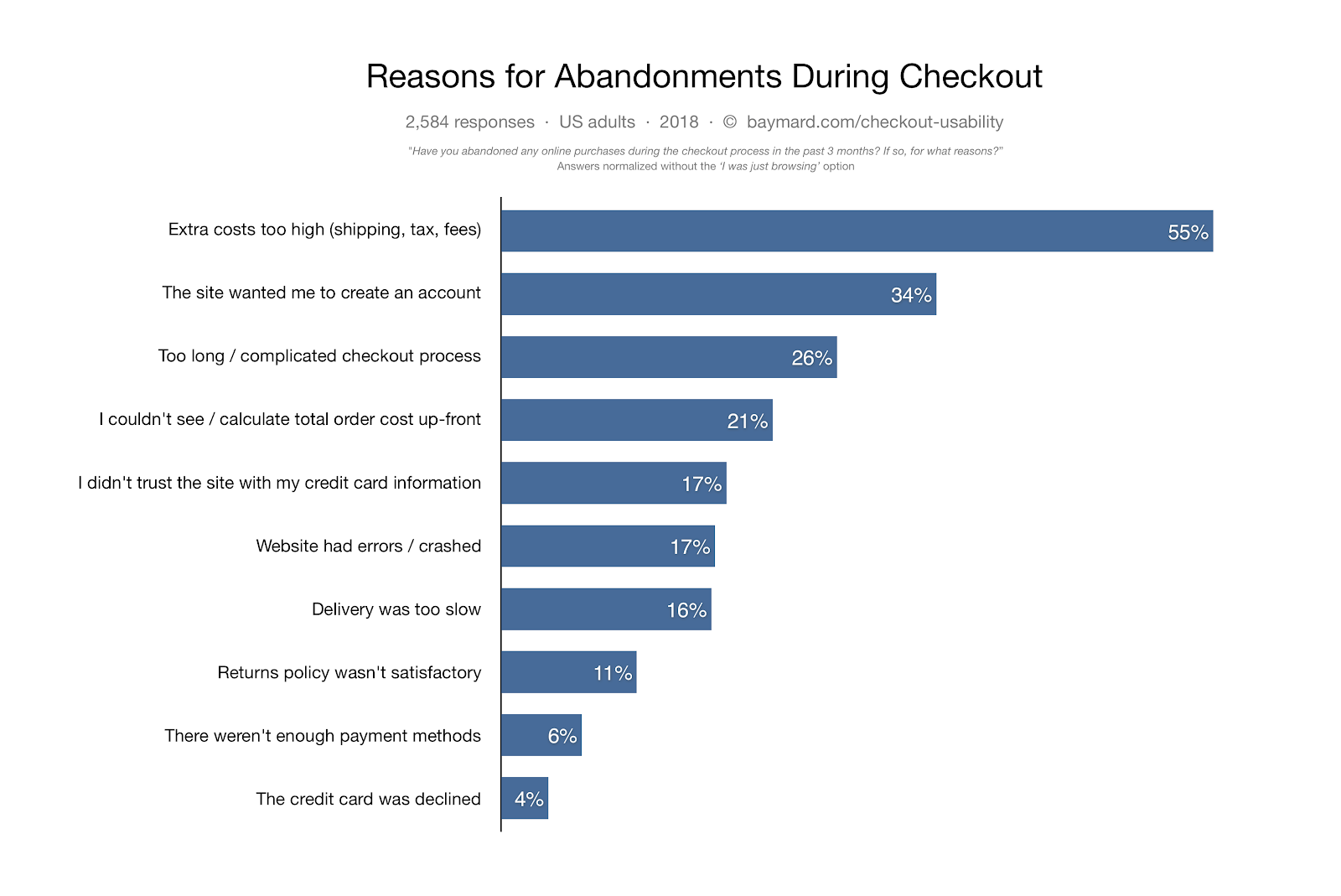It’s frustrating when you think of a customer getting all the way to the shopping cart, only to lose out on the sale. The good news is that there are proven ways to reduce your cart abandonment rates without totally overhauling your e-commerce store. In this post, we’ll share 7 proven tips to reduce cart abandonment.
Let’s face it, we all have been, at least once, frustrated to get a customer filling his cart with items, only for him to leave before completing the purchase. Unlike in the real world where customers just walk into your store, fill their shopping cart and go to the cashier to pay, in the world of e-commerce, customers get distracted more frequently, whether it is by the ads of one of your competitors, or by this video of a small dog playing football. I mean, it already happened to all of us, start our shopping on an e-commerce website, then find ourselves 3 hours later watching the 4th episode in a row of our favorite TV show (Rick and Morty, of course) and never return to that website again.
The good news is, there are proven strategies to reduce cart abandonment and checkout drops. In this article, we’re gonna discuss the main reasons behind these behaviors and provide practical solutions to implement in order to reduce your cart abandonment and checkout drops.
But before we get started, let’s go through the basics and define the terms for those who may not know them.
- Shopping cart abandonment: When a customer adds an item to his shopping cart but leaves the e-commerce store before completing the purchase.
- Checkout process: The process of buying the products after a customer puts them in his shopping cart. It includes several steps: filling in the shipping information, payment information, confirming the order and the payment.
- Checkout drop: When a customer leaves your website during the checkout process.
According to Statista, in 2018, 7 out of 10 shopping carts were abandoned, it's huge. Decreasing your cart abandonment rate can have a big impact on your bottom line and to do it, you’ll need first to understand the reasons behind it:

As you can see in the graph above from Baymard’s study on cart abandonment, the main reasons behind these drops are related to:
- Extra costs (shipping, fees, taxes) that made the total cost either too high or unclear for the customer.
- The customer experience in itself with a complicated checkout process, a mandatory account creation or unclear return policies.
- The payment, whether it is a lack of methods or a lack of trust.
According to a study made by Business Insider, another reason for abandoning shopping carts is, customers aren’t ready to purchase as they were are browsing to compare final prices with other e-commerce websites or just wanted to save the cart for later.
With that in mind, we can assume that it’s almost impossible to cut down your abandonment rate entirely as some people will inevitably leave before crossing the line and making a purchase. However, it’s definitely not impossible to address some of the issues stated above and thus improve your conversion rates. For that, in the next part of the article, we’ll be looking at 7 optimisation ways:
1. Offer Free Shipping:
As you’ve seen it above, shipping is the major reason for cart abandonment. I mean there’s nothing more frustrating than expecting to pay one price, then only to find at the end that you’ll have to pay outrageous shipping costs. In a study conducted by Invesp about the influence of free shipping in the online buying decision, orders with free shipping average around 30% higher in value and 93% of online customers are encouraged to buy more products if free shipping is available. So offering free shipping does not only help you decrease your cart abandonment rate but also increase your average order value.
You can also use it as a powerful marketing option to differentiate yourself from your competition but (yes, there’s always a but) free doesn’t mean free of cost. You’ll still need to pay for the logistics provider to get your products delivered to your customers.
In the case offering free shipping is not profitable for your business, there are still many good ways to implement it. Offering it only when a certain threshold is reached for the order is one way out many others. Amazon, for example, uses the $25 as the threshold. Don’t set any random price, make sure that the amount you choose covers the shipping costs.
Knowing that 9 out of 10 consumers say free shipping is the number 1 incentive to shop online more, showcasing it on your home page can help you convert more leads into customers as soon as they enter your website. Clarifying your shipping costs upfront will definitely help you build trust with your visitors. Daniel Wellington, for example, advertises it prominently on its homepage:

If you want to know more, check our article about the 4 best shipping strategies for an e-commerce website.
2. Implement a single page checkout:
One of the best ways to reduce shopping cart abandonment and checkout drops is to eliminate all the unnecessary pages during the checkout process.
As we’ve seen it above, one of the main reasons for customers leaving your website is, the checkout process is either too long or complicated. (customers don’t want to go through 5 or 6 different pages to complete their purchase)
Providing a single page checkout gives customers an incentive to complete the transaction by having all the required fields on the same page and thus making simpler and faster. It also gives fewer reasons for your visitors to leave the page and skip off to another tab.
An important thing to keep in mind when designing your single page checkout is to de-clutter it as much as possible. Try to limit the amount of information you ask, use smart forms and leverage Google’s autofill to make it easier for users to check out.
Also, make sure to remove on the checkout page all the links, ads and navigations that don’t support your end goal of converting the visitor into a customer. This will reduce the number of attractions that he has and thus boost your conversion rates.
According to an experiment run by Invesp, in some cases, a single-page checkout is better than a multi-page, while in other cases multi-page converted better. When it comes to high priced products, the multi-page process performed better while single-page checkouts converted better when the average order value was low. So try to A/B test, and see which one is better for your business.
In case, you opt for a multi-page checkout, make sure to include a progress indicator on the pages. This will reassure visitors regarding the time they’re going to spend on your website. It also makes the process clearer and easier to understand.
You can also track during which stage of the checkout process your customers leave your website. This will help you determine where the leaky spots are in your funnel and thus take the necessary actions to boost your conversions.
TIP: Include the remember me button, so that your customers won’t have to fill all their information (if they want, of course) next time they purchase from your website.
3. Enable guest checkout:
Asking your customers to mandatory create an account before completing the checkout process is definitely one of the most frustrating things for them (I am not surprised to see it ranked as the second biggest reason for cart abandonment). Filling the form, confirming an email address, and then returning to the checkout page is a lot to ask of a customer who may like your products but doesn’t necessarily want to build a relationship with you (and receive an email with your amazing offers every 2 or 3 days).
In his article about enabling guest checkouts, Jared M. Spool tells the story of when one shopper told them that he was not there to enter into a relationship, but he just wanted to buy something. Deleting the mandatory sign up (by changing only one button) helped him increase a retailer’s site annual revenues by $300 million.
Removing the mandatory sign-up will make the process easier for your customers and thus boost your sales and conversion rates. You might miss some of the data that every e-commerce wants, but if you offer a smooth experience, these customers are more likely to come back in the future.
TIP: You can still integrate the option for signing up in some other stages:
- Ask users if they wanna sign up after completing their purchase on the ‘Thank You’ page (we hope you’ve got one).
- Allow users to sign up directly with their social media accounts.
4. Offer secured payment:
After all the stories that happened lately with websites losing their customers' private information (yes, I'm talking about you Target), people are increasingly worried about their payment and personal data privacy.
Showing your visitors that your site and their information is secure can help you build trust and this will be a big push for them to shop on your website. The easiest way is:
- Have a valid SSL Certificate. If it’s out of date, your customers will be warned by their browser that the connection is not secure.
- Show security and trust badges for online payment.
According to the Baymard Institute, here are the most trusted SSL and trust seals:

Don’t forget to provide different payment methods depending on your customers. You can also use online payment services such as Paypal or Google Pay
5. Provide clear communication and 24/7 customer support:
Your customers will inevitably have questions during their journey on your website, thus providing clear and easily accessible information about your processes is crucial.
A great way to do so is by designing a well-organized FAQ and help centers. You’ll need to make sure it is visible and easy to access for your customers in case they have a question regarding your products or your processes. Knowing that unclear information about return and shipping processes are one of the top reasons for cart abandonment, you’ll need to clearly highlight and showcase your return policy and shipping details (time, cost, methods, etc).
In order to offer 24/7 support, you can integrate a live chat, as 53% of customers prefer to use online chat before calling a company for support. It is an effective way for hesitant customers who are about to checkout. It also provides a better solution to email, which is too slow, and phone calls, which get in the way of the checkout process. Botmind, for example, is a hybrid chatbot solution that can automate 40% of your chat support.
If you want to know more about customer service, don't hesitate to check our last article on the best helpdesks and customer support tools.
6. Optimise navigation and shopping cart experience:
In order to reduce your checkout drops and cart abandonment rate, you’ll also have to optimise your shopping cart experience (logical, right?).
Make sure to provide easy access to your shopping cart, also allow smooth navigation between cart and store because the easier you make it for your customers, the more likely they’re to checkout.
So first, make sure that the shopping cart is always visible on every page of your website. The easier you make it for your customers, the more likely they’re to go all the way through checkout. Try to eliminate all friction by integrating your shopping cart as a pop-up page that would show without having to go back and forth (the only back you want, is the one in “come back”).
Then, offer customers the chance to buy immediately or continue shopping so that whenever your customer lands on a product page, he can purchase the product directly or add the product to the cart and continue shopping. Also, allow the users to update the quantity of items during the checkout process without having to delete the whole selection.
Finally, use persistent shopping carts so that your visitors can find the selection from their previous abandoned cart. This will help them gain time and pick up from where they left off next time.
7. Reach out to your customers:
Some abandonment can not be prevented but some can be converted with a little push. You can use retargeting through Facebook’s Pixel by adding a tag on your website and use it to track visitors who don’t make it till the finish line and attract them back to your website.
You can also opt for recovery emails to remind them about the abandoned items. This should be done a few hours after the visitors leaves your site and a good way to make it effective can be to share a coupon code or offer other incentives such as gifts and free shipping.
In case you have all the data on your customer, such as a phone number, you can reach out to them directly by a call. This will show that you care about them and thus build trust. It will help you understand the reasons why they abandoned their cart and how can you help them. This personal outreach can be a real opportunity to build a long-lasting relationship.
There are many ways to reduce your cart abandonment rate and checkout drops. Some of the strategies we mentioned above might take more effort than others but they’re all worth trying. Make sure to test all of them to see which one works best for your e-commerce. This will already give you a good base to optimise your conversation rates and thus boost your sales.



.webp)
.webp)







